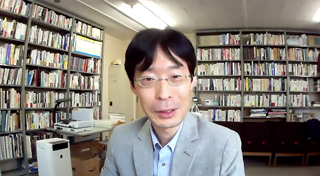JMT Web NewsINDUSTRY TOPICS
Japan’s Music Products Market: Tips and the Prospects from An Expert

Japan Musical Instruments Association(JMIA) held the first webinar on April 12 inviting Tomoaki Tanaka, associate professor of Tokyo Keizai University (photo). It was part of the association’s new projects to be held regularly to upgrade services for the members. He completed 2019 Japanese Music Products Manufacturers Survey commissioned by JMIA last December.
In the opening remarks, Masato Oshiki, director of General Affairs of JMIA remarked, “We found last fall through questionnaire addressed to the members that they liked seminars helpful for their business, and innovative ideas to promote music making and market development. This webinar was held as the first program of the project serving their request.” A total of 100 industry leaders attended. The webinar will be archived and offered free view for JMIA members and for a fee for non-members.
The following is excerpts of Tomoaki Tanaka’s 80-minute webinar.
1. Japan’s Economic Index and Music Products Industry
Japanese GDP has grown consecutively since 2009 with the highest growth rate in 2000s specifically in the recent 8 years after 2013. Japan enjoyed excellent economy in the latter half of 2010s.
However, given that average annual growth rate remained below 2% level in the last 5 years, it is in a moderate downturn trend.
Economic prospect for coming years is unforeseeable partly because of COVID19, economists predict 3% growth in 2021. It is supposed to take several years to return to the level of 2019.
On the other hand, domestic demands and household expenditure has not been much influenced by economic fluctuation. During the peak period from 2013 to 2019, domestic demands and household expenditure kept same level of growth.
2. Size of Japan’s Music Products Market
According to public and private survey data, music products market is shrinking in a long run in Japan with minimum increase or flat sales during the last couple of years.
Backed by ‘Stay Home’ demands for items of limited categories, music products sales in 2021 are expected to be not much affected, just a minimum decline.
2017 Leisure Report shows population of music makers (Western style music) was 14.4 million in 2009. In 2016 it went down to 7 million.
It is estimated that the size of Japan’s music products market was 240 billion Yen in 2016. (source: Commerce Survey by The Ministry of Economy, Trade and Industry). It presumably went down to 200 billion Yen in 2020.
After 1972, music products sales including CDs and software increased during 1990s with total sales of nearly 800 billion Yen annually from 1997 to 1999, the highest level in the history.
3. Comparison with other industries
Music products market is smaller in size than sports, automobile, consumer electronics, casual clothing, drug store and travel industries, but the 3rd largest in growth rate in 2019.
Sports market with 1.5 trillion Yen annual sales is well comparable with the music products industry. It employs the same type of sales marketing featuring popular athletes in advertisement and has huge school market as well. Their marketing strategies may also work for the music products industry.
Some manufacturers in the music products industry are increasingly shifting from selling goods to providing consumer with fun experience these days. Sharing the same marketing philosophy, the industry competes directly with travel industry which gains 7.2 trillon Yen sales annually. Some people would argue that the two industries are ultimately different, nonsense to compare. Just think, households must always make decisions how much and for what they spend their money. It is wrong to assume that music products and the services the industry offer are immune to products and services provided by outside industries.
4. Tips for the industry
Despite declining birth rate, after school evening group classes are flourishing. People like to spend more money on practical and useful goods and services. Declining birth rate does not necessarily mean diminishing demands for musical instrument and music making.
Though people do not spend much money for music lesson than they used to be, tuition for music lesson is regarded worthful second only to sports-related lesson. It suggests music retailers can raise tuition for music lesson to get extra money, but they must make sure that they are offering students value-added services.
A survey shows that senior population from 65 years old to 75 years old who chose mobile payment increased 50% in 2020 than a year before. Over 90% of male population of this age group have Internet access and they favor brand-new gadgets. Also, women population of this age group prefer outings. They tend to behave and think like young people in their 20s, not much appreciate music making and received wisdom such as it helps keep healthy brain and physical functions. In terms of market development, music products industry has two prospective target groups, those young and young at heart.
Music products industry has a sizable 400 billion Yen market excluding related software, more than two times of the current level. Newly hired employees at your office may turn your concept of marketing and boost the industry business with unprecedented ideas and strategies unrestricted by the industry’s stereotype practice.
